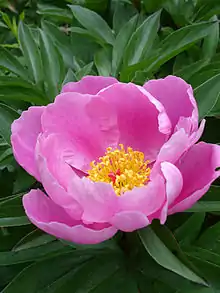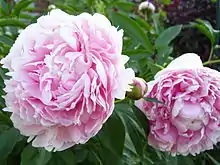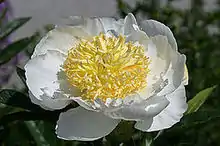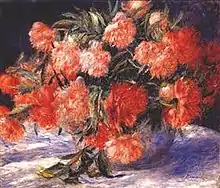Paeonia lactiflora
Paeonia lactiflora (Chinese peony or common garden peony) is a species of herbaceous perennial flowering plant in the family Paeoniaceae, native to central and eastern Asia from eastern Tibet across northern China to eastern Siberia.
| Paeonia lactiflora | |
|---|---|
 | |
| Paeonia lactiflora | |
| Scientific classification | |
| Kingdom: | Plantae |
| Clade: | Tracheophytes |
| Clade: | Angiosperms |
| Clade: | Eudicots |
| Order: | Saxifragales |
| Family: | Paeoniaceae |
| Genus: | Paeonia |
| Species: | P. lactiflora |
| Binomial name | |
| Paeonia lactiflora | |
| Synonyms | |
Description
It is 50–70 cm (20–28 in) tall and broad, with 9-lobed leaves 20–40 cm (8–16 in) long.
The flower buds appear in late spring (May in the Northern Hemisphere). They are large and round, opening into fragrant, cup- or bowl-shaped flowers 8–16 cm (3–6 in) in diameter, with 5–10 white, pink, or crimson petals and yellow stamens.[1]
Background
Paeonia lactiflora was known as the white peony (P. albiflora) when first introduced into Europe.[2] It was brought to England in the mid-18th century, and is the parent of most modern varieties.
The Latin specific epithet lactiflora means “with milk white flowers”.[3]
In China, P. lactiflora is likened to "the Minister of Flowers" (花相), while Paeonia × suffruticosa is known as "the King of Flowers" (花王).[4]
Cultivars

There are several hundred selected cultivars in a range of colours, sizes and forms; many have double flowers, with the stamens modified into additional petals.[5] There are many colors now available, from pure milk white, to pink, rose, and near red, along with single to fully double forms. They are prolific bloomers, and have become the main source of peonies for the cut flower business.[2]
The following cultivars have gained the Royal Horticultural Society's Award of Garden Merit:[6]
- 'Bowl of Beauty'[7] (double, pink & cream)
- 'Coral Charm' [8] (salmon pink)
- 'Duchesse de Nemours'[9] (double white)
- ’Felix Crousse’[10] (double deep pink)
- ’Festiva maxima’[11] (double white)
- 'Laura Dessert'[12] (double white)
- 'Miss America'[13]
- ’Monsieur Jules Elie’[14] (double pink)
- 'Sarah Bernhardt'[15] (double pink)
- 'Whitleyi Major'[16] (single white, prominent stamens)

Chemistry
The leaves of many cultivars are high in oleanolic and ursolic acid.[17]
Phenolic compounds
Cis-epsilon-viniferin, trans-resveratrol, trans-resveratrol-4'-O-beta-D-glucopyranoside, trans-epsilon-viniferin, gnetin H, and suffruticosol A, B[18] and paeoniflorin esters[19] can be found in P. lactiflora.
Petals color is dependent on a UDP-glucose: Flavonoid 5-O-glucosyltransferase expressing anthocyanins such as peonidin-3,5-di-O-glucoside, pelargonidin-3,5-di-O-glucoside, cyanidin-3,5-di-O-glucoside, peonidin-3-O-glucoside, cyanidin-3-O-glucoside, peonidin-3-O-glucoside-5-O-arabinoside, cyanidin-3-O-glucoside-5-O-galactoside and pelargonidin-3-O-glucoside-5-O-galactoside.[20]
In art and culture

Paeonia lactiflora became a popular still life subject for Impressionist artists in the late 19th century.
- Pierre-Auguste Renoir featured Peonies in multiple paintings from the 1870s through the 1890s.[21] The Independent wrote of his fondness for the flower that: "They had been introduced into the horticultural world of Paris in the 1860s, so there was still something of the exotic about them, and Renoir paints them rather solemnly and majestically."[22]
- Vincent van Gogh painted "Vase with Peonies", "Bowl with Peonies and Roses"[23] and "Vase with cornflowers and poppies, peonies and chrysanthemums", all in 1886.[24]
- Claude Monet painted "Vase of Peonies" in 1882.[25]
- Edouard Manet cultivated peonies in his garden and painted them frequently. The Impressionist artist Frédéric Bazille painted "Young Woman with Peonies" in 1870 as a tribute to his friend Manet, knowing his fondness for the flower.[26]
References
- RHS A-Z encyclopedia of garden plants. United Kingdom: Dorling Kindersley. 2008. p. 1136. ISBN 978-1405332965.
- Halda, Josef J.; Waddick, James W. (2004). The Genus Paeonia. Timber Press. pp. 196–205. ISBN 978-0-88192-612-5.
- Harrison, Lorraine (2012). RHS Latin for Gardeners. United Kingdom: Mitchell Beazley. ISBN 978-1845337315.
- ""花相"字的解释 | 汉典". www.zdic.net (in Chinese). Retrieved 2020-01-12.
- Loewer, H. Peter (1999). Fragrant Gardens. Houghton Mifflin Gardening. pp. 48. ISBN 978-0-395-88492-8.
Peony common garden.
- "AGM Plants - Ornamental" (PDF). Royal Horticultural Society. July 2017. p. 71. Retrieved 14 April 2018.
- "RHS Plant Selector - Paeonia lactiflora 'Bowl of Beauty'". Retrieved 16 January 2021.
- "Paeonia lactiflora 'Coral Charm'". RHS. Retrieved 18 January 2021.
- "RHS Plant Selector - Paeonia lactiflora 'Duchesse de Nemours'". Retrieved 16 January 2021.
- "RHS Plantfinder - Paeonia lactiflora 'Felix Crousse'". Retrieved 14 April 2018.
- "RHS Plantfinder - Paeonia lactiflora 'Festiva maxima'". Retrieved 14 April 2018.
- "RHS Plant Selector - Paeonia lactiflora 'Laura Dessert'". Retrieved 16 January 2021.
- "Paeonia lactiflora 'Miss America'". RHS. Retrieved 18 January 2021.
- "RHS Plantfinder - Paeonia lactiflora 'Monsieur Jules Elie'". Retrieved 14 April 2018.
- "RHS Plant Selector - Paeonia lactiflora 'Sarah Bernhardt'". Retrieved 16 January 2021.
- "RHS Plant Selector - Paeonia lactiflora 'Whitleyi Major'". Retrieved 16 January 2021.
- Zhou C, Zhang Y, Sheng Y, Zhao D, Lv S, Hu Y, Tao J.,"Herbaceous Peony (Paeonia lactiflora Pall.) as an Alternative Source of Oleanolic and Ursolic Acids." Int J Mol Sci. 2011;12(1):655-67
- Kim, H. J.; Chang, E. J.; Cho, S. H.; Chung, S. K.; Park, H. D.; Choi, S. W. (2002). "Antioxidative activity of resveratrol and its derivatives isolated from seeds of Paeonia lactiflora". Bioscience, Biotechnology, and Biochemistry. 66 (9): 1990–1993. doi:10.1271/bbb.66.1990. PMID 12400706. S2CID 24367582.
- Yan, D.; Saito, K.; Ohmi, Y.; Fujie, N.; Ohtsuka, K. (2004). "Paeoniflorin, a novel heat shock protein–inducing compound". Cell Stress & Chaperones. 9 (4): 378–89. doi:10.1379/CSC-51R.1. PMC 1065277. PMID 15633296.
- Isolation of a UDP-glucose: Flavonoid 5-O-glucosyltransferase gene and expression analysis of anthocyanin biosynthetic genes in herbaceous peony (Paeonia lactiflora Pall.). Da Qiu Zhao, Chen Xia Han, Jin Tao Ge and Jun Tao, Electronic Journal of Biotechnology, 15 November 2012, Volume 15, Number 6, doi:10.2225/vol15-issue6-fulltext-7
- "'Peonies' Pierre Auguste Renoir". clarkart.edu. Retrieved 2018-04-17.
- Michael Glover (2013-08-16). "Great works: Onions (1881) by Pierre Auguste-Renoir". The Independent. Retrieved 2018-04-17.
- "Roses and Peonies, June 1886". krollermuller.nl. Retrieved 2018-04-17.
- "Vase with Peonies by Vincent Van Gogh". vangoghgallery.com. Retrieved 2018-04-17.
- "Vase of Peonies, 1992 - Claude Monet". wikiart.com. Retrieved 2018-04-17.
- "Manet and His Influence". National Gallery of Art. p. 8. Retrieved 2018-04-17.
External links
| Wikispecies has information related to Paeonia lactiflora. |
| Wikimedia Commons has media related to Paeonia lactiflora. |
